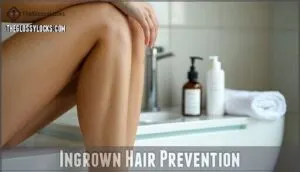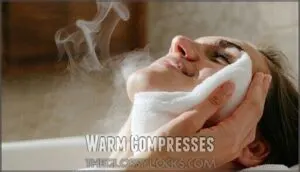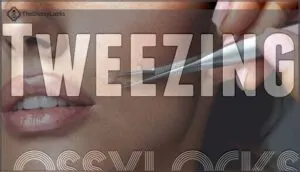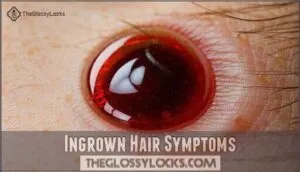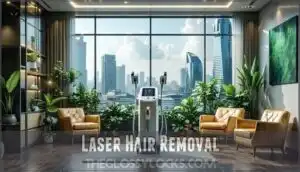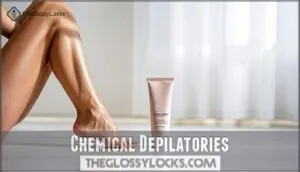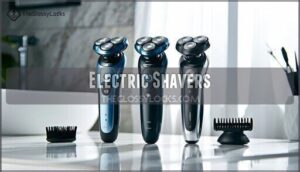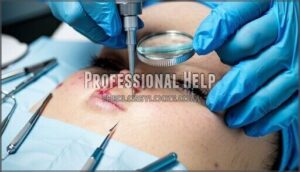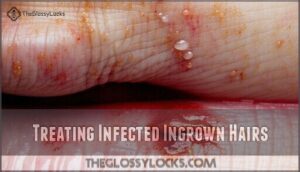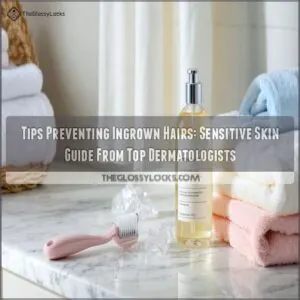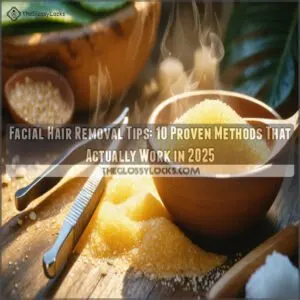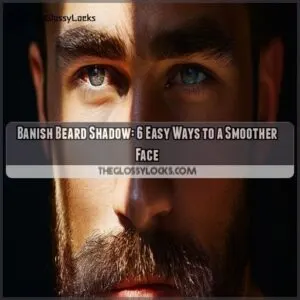This site is supported by our readers. We may earn a commission, at no cost to you, if you purchase through links.
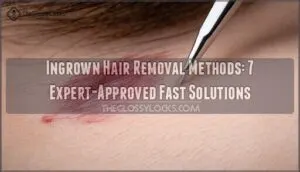 Dealing with ingrown hairs can feel like fighting a losing battle, but you’ve got options that actually work.
Dealing with ingrown hairs can feel like fighting a losing battle, but you’ve got options that actually work.
Start with warm compresses to soften the skin, then gently exfoliate to free trapped hairs.
For stubborn cases, sterile tweezers can help extract visible hairs.
Chemical exfoliants like salicylic acid prevent future occurrences by keeping follicles clear.
Professional treatments include laser hair removal and electrolysis for long-term solutions.
Severe infections need medical attention – don’t play doctor with pus-filled bumps.
The key to mastering ingrown hair removal methods lies in matching the right technique to your specific situation and skin type.
Table Of Contents
- Key Takeaways
- Ingrown Hair Causes
- Ingrown Hair Prevention
- Home Remedies
- Ingrown Hair Symptoms
- Ingrown Hair Removal
- Treating Infected Ingrown Hairs
- Professional Help Options
- Frequently Asked Questions (FAQs)
- What is the most effective way to remove ingrown hairs?
- How do you draw out deep ingrown hairs?
- How to get rid of an ingrown hair lump?
- How do you remove ingrown hair?
- How to get rid of an ingrown toenail?
- How to get rid of ingrown hair without shaving?
- What are the different types of ingrown hair treatments?
- Can a dermatologist remove a deep ingrown hair?
- How do I get rid of underarm ingrown hairs?
- What is the best hair removal method for ingrown hairs?
- Conclusion
Key Takeaways
- Start with warm compresses and gentle exfoliation – You’ll soften the skin and help trapped hairs surface naturally before attempting any removal methods.
- Use sterilized tweezers only when hair’s visible – Don’t dig for buried hairs, as this can cause infection and scarring that’ll make your problem worse.
- Consider professional treatments for stubborn cases – Laser hair removal and electrolysis provide permanent solutions when home remedies aren’t cutting it.
- Seek medical help for infected ingrown hairs – You need prescription antibiotics or steroid injections when there’s pus, spreading redness, or worsening pain.
Ingrown Hair Causes
Before you can tackle ingrown hairs, you need to understand what’s causing them in the first place.
Several factors work together to trap hair beneath your skin’s surface, creating those annoying bumps that can turn into painful, infected spots if left untreated.
Hair Removal Methods
Hair removal methods can be your skin’s worst enemy in regards to ingrown hairs.
Shaving creates razor-sharp edges that pierce back through your skin like tiny daggers.
Waxing yanks follicles, causing trauma that forces regrowth sideways.
Tweezing disrupts natural growth patterns, while depilatory creams weaken hair structure.
Here’s how different hair removal techniques sabotage your skin:
- Shaving techniques with dull blades create jagged hair ends that easily re-enter skin
- Waxing benefits include longer results, but follicle damage increases ingrown risk
- Tweezing risks involve pulling skin taut, forcing hairs to grow beneath the surface
- Depilatory creams chemically weaken hair, making it curl back into follicles
- Laser hair removal and electrolysis cost more upfront but eliminate future ingrown problems
Curly or Coarse Hair
Your hair texture determines your ingrown hair risk more than you might think.
People with curly hair face higher odds because those natural spirals create the perfect storm for follicle shape problems.
Your genetic predisposition means curved follicles encourage hairs to loop back into skin after removal.
Understanding this connection helps you choose better ingrown hair removal strategies and specialized products for prevention.
Improper Hair Removal Techniques
Beyond genetic predisposition, your technique can make or break your hair removal game.
Poor methods practically invite hairs to stage an underground rebellion beneath your skin’s surface.
- Dull razors drag and tear follicles instead of slicing cleanly
- Shaving against-grain forces stubble back into skin pores
- Pulling skin taut during removal creates unnatural hair angles
- Tweezing trauma from improper grip damages follicle structure
- Waxing mistakes like reapplying strips cause breakage mid-follicle
These hair removal techniques create sharp edges that pierce skin during regrowth, triggering inflammation and those familiar red bumps you’re trying to avoid.
Shaving with dull razors or against the grain substantially increases the risk of razor bump formation.
Dead Skin Cells and Follicle Clogging
Throughout each day, your skin naturally sheds dead cells that don’t always fall away properly.
When these cellular remnants accumulate around hair follicles, they create barriers forcing new hairs sideways or backward instead of upward.
Regular exfoliation removes this buildup, preventing clogged pores.
Product buildup worsens the situation, creating keratin plugs that trap hairs beneath the surface.
Maintaining proper skin hydration helps prevent dead skin cells from blocking follicles and causing follicle trauma.
Friction From Tight Clothing
Your beloved yoga pants might be sabotaging your skin’s recovery.
That tight-fitting activewear could be your skin’s worst enemy when it comes to ingrown hairs.
Tight clothing creates relentless friction against freshly shaved areas, forcing cut hairs to curve inward instead of growing naturally upward.
Compression garments and snug post-workout wear trap moisture and heat, creating perfect conditions for skin irritation.
Switch to looser clothing made from breathable clothing material with superior fabric breathability.
This simple change gives your follicles room to heal properly, making ingrown hair prevention as easy as choosing comfort over constriction.
Skin Conditions and Inflammation
Before your follicles, skin conditions like eczema, acne, or folliculitis create inflammation that disrupts normal hair growth patterns.
These underlying conditions compromise your skin’s barrier function and trigger immune responses that trap emerging hairs beneath the surface.
Inflammation triggers include:
- Bacterial infections in hair follicles
- Allergic reactions to skincare products
- Hormonal fluctuations affecting sebum production
- Chronic dermatitis creating persistent irritation
- Poor wound healing from previous skin irritation
Managing these conditions reduces hyperpigmentation risks and prevents scarring.
Ingrown Hair Prevention
You can’t always prevent ingrown hairs, but the right techniques make a huge difference.
Following proven prevention methods stops most ingrown hairs before they start and keeps your skin smooth between hair removal sessions.
Exfoliation Methods
Regular exfoliation breaks the cycle of trapped hairs by clearing dead skin cells from your follicles.
You’ve got two main approaches: physical exfoliation using brushes or scrubs, and chemical peels with alpha hydroxy acids or beta hydroxy acids like glycolic and salicylic acid.
| Exfoliation Type | Best For |
|---|---|
| Physical (scrubs, brushes) | Quick results, visible debris removal |
| Chemical (AHA/BHA acids) | Sensitive skin, deeper pore cleansing |
| Combination approach | Stubborn ingrown hair prevention |
Your exfoliation frequency matters—aim for 2-3 times weekly, not daily.
Overdoing it irritates skin and worsens the problem.
Post-exfoliation care includes moisturizing immediately to maintain your skin’s barrier.
These ingrown hair prevention techniques work best when you’re consistent, giving your skin time to adjust to new exfoliating tools and routines.
Choosing The Right Razor
Your razor choice directly impacts ingrown hair formation. Choose razors with one or two blade count options—multi-blade cartridges increase irritation risk.
Look for moisture strips and secure handle grip for better control during shaving techniques. Razor maintenance matters: clean blades after each use, replace weekly.
Single-blade safety razors often outperform disposable razors for sensitive skin, reducing razor blades‘ aggressive cutting action that causes hairs to retreat below skin surface. Many users consider the optimal blade quantity for a closer shave.
Reducing Shaving Frequency
While a sharp razor matters, how often you shave plays an equally important role in ingrown hair prevention.
Cutting back your shaving frequency gives your skin precious skin recovery time between sessions.
Instead of daily razor encounters, try every other day or twice weekly—this respects your natural hair regrowth cycle.
Alternative methods like electric shavers offer gentler stubble management without constant blade contact.
These shaving alternatives among hair removal methods help achieve hair growth reduction while letting irritated follicles heal completely, breaking the cycle of recurring ingrown hairs.
Wearing Looser Clothing
Beyond reducing shaving frequency, your fabric choice plays a major role in ingrown hair prevention. Tight clothing creates constant pressure against follicles, forcing hairs back into skin.
Switch to looser clothing made from breathable materials for ideal skin comfort:
- Cotton and linen offer superior circulation benefits
- Moisture-wicking fabrics prevent bacterial buildup around follicles
- Relaxed fits eliminate friction reduction needs in sensitive areas
These style options give your skin room to breathe while preventing those pesky ingrown hairs from forming.
Using Shave Gel or Cream
Beyond choosing breathable fabrics, you’ll want to lubricate your skin properly before shaving.
Shaving gel or cream creates a slippery barrier that lets your razor glide smoothly across your skin. This lubrication reduces friction and prevents hair from getting trapped under the surface.
Look for products with aloe vera or other soothing ingredients that work well with skin sensitivity. Apply the gel using circular motions to lift hairs upward, making your shave cleaner and reducing ingrown risks substantially.
Many users seek solutions for shaving gel ingrowns.
Home Remedies
You can tackle stubborn ingrown hairs at home using simple, effective remedies that work with your skin’s natural healing process.
These gentle methods help coax trapped hairs to the surface while reducing inflammation and preventing infection, which are complete concepts that support the skin’s natural healing process.
Warm Compresses
Gentle heat therapy becomes your first line of defense against stubborn ingrown hairs. Apply a warm compress using a clean washcloth soaked in comfortably warm water for 10-15 minutes, repeating this process 3-4 times daily to maximize compress benefits.
The ideal compress temperature softens skin tissues and increases circulation, encouraging trapped hairs to surface naturally through inflammation reduction. This compress therapy method requires consistent application frequency for best results.
- Feel the relief as warmth melts away tension and discomfort from angry, inflamed follicles
- Experience freedom from painful bumps through this gentle, non-invasive ingrown hair treatment approach
- Regain confidence knowing you’re using proven compress materials that dermatologists recommend for effective ingrown hair remedies
Tweezing
When you can see the hair loop breaking through your skin’s surface, you’re ready for safe ingrown hair removal through proper tweezing techniques.
Start with tool sterilization using rubbing alcohol on your slant-tip tweezers. Hair preparation involves applying a warm compress first to soften the area. For pain management, ice the spot beforehand.
Use the correct tweezing technique: grasp close to skin and pull in the growth direction.
Aftercare advice includes applying soothing gel and keeping the area clean to prevent infection. It’s also important to note that tight clothing can contribute to ingrown hairs.
Gentle Exfoliation
Dead-cell buildup acts like a roadblock, trapping hairs beneath your skin’s surface and creating those frustrating bumps you’re trying to eliminate. Gentle exfoliation becomes your secret weapon, clearing away cellular debris while freeing trapped hairs naturally.
Master these skin exfoliation techniques for ideal results:
- Practice proper exfoliation frequency: 2-3 times weekly to avoid over-irritation
- Choose chemical exfoliants with salicylic acid for sensitive skin types
- Use physical exfoliation with soft brushes in circular motions
- Follow post-exfoliation care by moisturizing immediately after treatment
Skin smoothing occurs gradually, so you’ll need patience while your exfoliating routine works its magic. Wait 24 hours after any skin exfoliation session before attempting hair removal, giving your newly refreshed skin time to recover and reducing irritation risk.
Apple Cider Vinegar Application
Apple cider vinegar’s natural acids tackle ingrown hair treatment head-on.
Mix ACV with water using a 1:2 dilution ratio, then apply with cotton balls twice daily.
The bacterial properties fight infection while promoting inflammation reduction. Those with skin sensitivity should start with weaker concentrations.
This simple home remedy delivers results within 3-5 days when you let each application frequency air dry completely.
Ingrown Hair Symptoms
You’ll recognize ingrown hairs by their telltale red, raised bumps that often resemble tiny pimples with white or yellow pus-filled heads.
The affected area typically feels tender, itchy, or painful to the touch, and you might notice swelling around the trapped hair follicle.
Redness and Pustules
Beyond the warm compresses, you’ll notice distinct redness and pustules as your immune system battles the trapped hair.
These infection signs develop through three key stages:
- Inflammation severity increases as white blood cells accumulate around the follicle
- Pustule formation occurs when dead immune cells create visible white-headed bumps
- Scarring risks emerge if you pick at inflamed areas
Redness causes stem from increased blood flow to affected tissues.
Apply antiinflammatory ingredients like hydrocortisone to minimize skin inflammation and prevent infection progression.
Itching and Pain
Beyond visible redness, you’ll feel the relentless itching and pain that makes ingrown hairs truly unbearable.
Your body’s inflammation response creates sharp, stabbing sensations when touched, while constant scratching worsens the condition.
For effective pain management, apply cold compresses or topical treatments containing soothing ingredients like hydrocortisone or tea tree oil.
These provide itch relief without aggravating the area, helping you regain control over persistent ingrown hair relief discomfort.
Pus or Drainage
While itching and pain are uncomfortable, pus or drainage from ingrown hairs signals a more serious concern.
You’ll notice yellowish or whitish pus composition that ranges from thin to thick consistency. Drainage color matters—greenish discharge indicates severe infection signs requiring antibiotics.
Treatment options include applying antiseptic solution, but persistent discharge needs medical attention.
Don’t ignore worsening symptoms, as untreated infections increase scarring risk. If drainage continues after home care or you develop an abscess, seek professional help immediately to prevent complications.
Swelling and Inflammation
Swelling and redness around ingrown hairs show your body’s inflammation response fighting the trapped follicle.
You’ll feel warmth, tenderness, and noticeable puffiness that peaks within 48-72 hours.
Cool compress types like damp washcloths provide swelling relief for 10-15 minutes.
Watch for infection signs like increasing pain or yellow discharge.
Gentle care prevents scarring prevention during ingrown hair removal.
Ingrown Hair Removal
You’ll find several effective methods to remove stubborn ingrown hairs when home remedies aren’t enough.
Professional treatments like laser hair removal and electrolysis offer long-term solutions, while chemical depilatories and electric shavers provide gentler alternatives to traditional razors, including electrolysis.
Laser Hair Removal
When symptoms persist despite home remedies, laser hair removal provides a game-changing permanent solution for ingrown hair removal.
This FDA-approved treatment targets hair follicles with precision, offering long-term freedom from recurring bumps and irritation across all skin types. The procedure utilizes FDA-approved lasers to target melanin.
- Laser efficacy reaches up to 90% hair reduction after multiple sessions
- Treatment cost proves economical compared to lifetime shaving expenses
- Works effectively on various skin types with advanced laser technology
- Multiple sessions (6-8 treatments) guarantee thorough hair follicle removal
- Potential risks include temporary redness, manageable with proper aftercare
Electrolysis
Electrolysis stands as the FDA-approved champion of permanent hair removal, targeting individual follicles with precise electric currents.
Unlike temporary fixes, this electrolysis treatment destroys hair-producing cells completely, preventing future hair regrowth and ingrown hairs.
A qualified electrologist uses specialized techniques to minimize skin damage while maximizing treatment efficacy.
Though electrolysis cost varies, the investment delivers lasting freedom from razor bumps.
Electrolysis safety records prove excellent across all skin types, making this your permanent solution.
The procedure involves destroying hair follicles directly, preventing regrowth.
Chemical Depilatories
Chemical depilatories break down your hair’s keratin structure using depilatory ingredients like calcium thioglycolate, dissolving strands just below skin level.
Unlike razors that create sharp edges, these hair removal creams leave blunt tips that won’t pierce back into your skin.
Test for skin sensitivity first—these powerful formulas can irritate delicate areas.
Master proper application techniques: apply thick, even layers on clean, dry skin for 3-10 minutes max.
Product comparisons show they’re gentler than waxing but require more frequent use than electrolysis.
For longer-lasting results, consider laser hair removal.
While hair regrowth occurs faster than root-removal methods, you’ll enjoy smoother results than shaving with reduced ingrown risk.
Electric Shavers
Precision becomes your ally when electric shavers replace traditional razors in your hair removal routine.
These devices cut hair at skin level without creating sharp edges that pierce back into follicles, substantially reducing ingrown hair formation. Electric shavers can help with ingrown hair issues.
Shaver advantages include:
- Foil vs Rotary options – Foil shavers work best for straight hair growth patterns, while rotary models adapt to facial contours and curly hair
- Corded or Cordless flexibility – Cordless models offer convenience, but corded versions provide consistent power for thick, coarse hair
- Skin sensitivity accommodation – Built-in guards protect delicate areas while maintaining effective hair removal
Regular shaver maintenance keeps blades sharp and hygienic, preventing bacterial buildup that could worsen ingrown hairs.
Professional Help
Sometimes stubborn ingrown hairs demand a dermatologist’s expertise when home remedies fall short.
These specialists offer prescription creams, advanced exfoliation treatments, and cutting-edge procedures like laser hair removal or electrolysis.
For severe cases, they’ll consider steroid injections or incision and drainage.
Professional surgical options prevent long-term scar reduction issues, making that investment worthwhile for your skin’s future health.
Treating Infected Ingrown Hairs
When an ingrown hair becomes infected, you’ll need stronger treatment methods to clear the infection and prevent complications.
Infected ingrown hairs demand immediate action before they spiral into scarring nightmares.
Don’t ignore signs like increasing redness, pus, or warmth around the area—these symptoms require prompt medical attention to avoid scarring or spreading infection.
Antibiotic Ointment
Antibiotic ointment application transforms infected ingrown hairs from painful problems into manageable healing opportunities.
When bacteria invade irritated follicles, topical antibiotics create a protective barrier while eliminating harmful microorganisms that cause swelling and pus formation.
Here’s your infection prevention game plan:
- Choose the right fighter: Bacitracin, neomycin, or polymyxin B ointments pack the strongest antibacterial punch
- Apply with precision: Use clean fingers or cotton swabs to spread thin layers over affected areas
- Stick to the schedule: Treatment works best with consistent 2-3 times daily application after cleansing
- Watch for rebellion: Discontinue immediately if redness, itching, or irritation worsens
- Store properly: Keep ointments at room temperature, away from heat and direct sunlight
Follow usage guidelines carefully—overuse won’t speed healing but might trigger side effects. If your skin rebels against treatment or infection persists beyond a week, it’s time to call in professional backup. Your dermatologist can recommend stronger antiseptic solutions or alternative treatments.
Steroid Injections
When topical treatments fall short, steroid injections provide powerful relief for stubborn infected ingrown hairs. Your dermatologist will inject corticosteroids directly into the affected area, rapidly reducing inflammation and allowing trapped hairs to surface.
The injection procedure is surprisingly quick—typically under five minutes. Most patients describe mild discomfort rather than significant pain, making pain management straightforward.
You’ll likely see improvement within 24-48 hours as swelling subsides. While injection side effects are generally minimal, some people experience temporary skin lightening or slight indentation at the injection site.
Scarring risks remain low when performed by trained professionals. The treatment effectively prevents hyperpigmentation that often follows severe ingrown hair infections. For long-term relief, consider how laser hair removal can help.
Steroid alternatives include topical corticosteroids, but injections work faster for deep, persistent cases. This targeted approach gives you control over recurring problems, offering freedom from the cycle of chronic ingrown hair removal struggles that resist other treatments.
Incision and Drainage
When conservative treatments fall short, incision and drainage offers a definitive solution for severe ingrown hair abscesses that won’t respond to other methods.
Your dermatologist performs this procedure overview using precise sterilization methods:
- Numbs the area with local anesthetic for pain management
- Creates a small, controlled incision using sterile instruments
- Drains accumulated pus and infected material completely
- Extracts the troublesome ingrown hair removal with sterile tweezers
- Applies antibiotic ointment to prevent reinfection
Scarring risks remain minimal when professionals handle the abscess.
Proper post-op care guarantees the best healing—keep the area clean and follow your dermatologist’s instructions precisely.
Seeking Medical Help
Most cases resolve with home care, but Persistent Cases require professional intervention.
When to Consult dermatologists: spreading redness, fever, or worsening pain after one week.
| Warning Sign | Action Needed | Treatment Options |
|---|---|---|
| Severe Infections with pus | Immediate medical attention | Antibiotics, incision and drainage |
| Scarring Concerns developing | Dermatologist consultation | Steroid injections, topical treatments |
| Pain Management unsuccessful | Professional evaluation | Prescription medications, medical advice |
| Recurring ingrown hairs | Long-term solution planning | Laser removal, electrolysis |
| Fever or systemic symptoms | Emergency care | Oral antibiotics, hospitalization |
Don’t tough it out—medical advice prevents complications.
Preventing Infection
Your skin’s defense system works best when you give it the right support. Preventing infection becomes straightforward when you establish proper habits early.
Follow these three infection prevention strategies:
- Cleanse twice daily with gentle antibacterial soap to maintain proper hygiene
- Apply antiseptic solution like diluted tea tree oil to eliminate harmful bacteria
- Use only sterilized tweezers when hair removal becomes absolutely necessary
Resist the urge to squeeze or pick at inflamed areas—this pushes bacteria deeper into tissue.
Cleanliness importance can’t be overstated for wound care success. Avoid squeezing inflamed bumps, as this compromises your infection prevention efforts and delays healing.
Professional Help Options
When home remedies aren’t cutting it, it’s time to call in the professionals.
Dermatologists have specialized treatments and prescription options that can tackle stubborn ingrown hairs more effectively than over-the-counter solutions.
Dermatologist Consultation
When home treatments fail, scheduling a dermatologist consultation gives you back control over stubborn ingrown hairs.
During your skin examination, dermatologists assess infection severity and develop personalized treatment plans suited to your specific needs.
They offer prescription strength topical antibiotics, steroid injections for inflammation, and treatment options like professional extraction using sterile techniques.
Dermatological recommendations address scarring concerns through specialized creams and preventative care strategies.
Don’t let infected ingrown hairs hold you hostage—medical advice from specialists guarantees safe, effective solutions that actually work.
Adapalene Gel Treatment
Targeting stubborn ingrown hairs with precision, adapalene gel treatment harnesses retinoid power to unclog follicles and prevent future bumps.
You’ll apply this Differin solution nightly, allowing the adapalene mechanism to accelerate cell turnover and clear blocked pores naturally.
- Start slow – Apply every other night initially to minimize irritation
- Expect gradual results – Most users see improvement within 2-4 weeks of consistent use
- Watch for side effects – Mild redness and peeling are normal during adjustment
- Maintain consistency – Daily application maximizes long-term ingrown hair solutions
- Combine wisely – Avoid harsh scrubs while using this retinoid treatment
Laser-assisted Hair Removal
Laser precision transforms your battle against stubborn ingrown hairs into a victory worth celebrating.
This permanent hair removal method targets hair follicles with concentrated light energy, destroying them completely.
You’ll typically need 6-8 sessions for maximum treatment efficacy, with NdYAG laser technology proving safe across various skin types.
Procedure safety remains excellent when performed by qualified professionals.
| Treatment Aspect | Details | Considerations |
|---|---|---|
| Sessions Needed | 6-8 treatments | Spaced 4-6 weeks apart |
| Effectiveness | 70-90% reduction | Best on dark, coarse hair |
| Cost Range | $100-500 per session | Varies by treatment area |
| Skin Compatibility | Most skin types | NdYAG works on darker skin |
Electrolysis Treatment
Electrolysis represents the gold standard for permanent hair removal, using a thin needle and shortwave radio frequencies to destroy hair follicles completely.
Unlike laser treatments, electrolysis effectiveness extends to all hair colors and skin types, making it ideal for stubborn ingrown hairs.
Here’s what you need to know about electrolysis:
- Treatment duration varies from 6-18 months depending on the area treated
- Electrolysis cost ranges from $30-200 per session, but prevents future ingrown hairs permanently
- Electrolysis side-effects include temporary redness and swelling that typically resolve within hours
Electrolysis aftercare involves keeping the treated area clean and avoiding sun exposure, ensuring ideal healing and results.
Frequently Asked Questions (FAQs)
What is the most effective way to remove ingrown hairs?
Apply warm compresses daily, gently exfoliate trapped hairs, and use sterilized tweezers when hair loops are visible. You’ll break free from irritation while preventing future occurrences through proper technique.
How do you draw out deep ingrown hairs?
Use warm compresses 3-4 times daily for 10-15 minutes to soften skin.
Apply gentle chemical exfoliants with salicylic acid to dissolve dead cells.
Once hair surfaces, carefully extract with sterile tweezers.
How to get rid of an ingrown hair lump?
Warm compresses soften the lump, making extraction easier. Gently exfoliate with salicylic acid to break down dead skin cells. You’ll see that stubborn bump finally surrender to consistent daily treatment.
How do you remove ingrown hair?
Gently exfoliate around the area using a soft brush or chemical exfoliant, then apply warm compresses to soften skin and help the trapped hair emerge naturally.
How to get rid of an ingrown toenail?
Like breaking free from a stubborn trap, treating ingrown toenails requires gentle persistence and proper technique.
Soak your foot in warm, soapy water for 15-20 minutes daily.
Gently lift the nail’s corner with a clean cotton ball or dental floss, then apply antibiotic ointment.
Wear loose-fitting shoes and trim nails straight across to prevent recurrence.
How to get rid of ingrown hair without shaving?
Apply warm compresses for 10-15 minutes daily to soften skin. Gently exfoliate with salicylic acid products to release trapped hairs. Use sterilized tweezers when hair’s visible, pulling in growth direction.
What are the different types of ingrown hair treatments?
Treatment options include topical exfoliants containing salicylic or glycolic acid, warm compresses, over-the-counter retinoids like adapalene, anti-inflammatory creams, gentle physical exfoliation, and professional treatments for persistent cases.
Can a dermatologist remove a deep ingrown hair?
When stubborn hairs dig deep like buried treasure, you’ll need a professional excavation.
Yes, dermatologists can safely remove deep ingrown hairs using sterile instruments and techniques, preventing scarring and infection that DIY attempts often cause, which requires a dermatologist.
How do I get rid of underarm ingrown hairs?
Exfoliate gently with salicylic acid products twice weekly to unclog follicles. Apply warm compresses for 10-15 minutes daily, then moisturize. Switch to loose-fitting, breathable clothing to reduce friction and irritation.
What is the best hair removal method for ingrown hairs?
Laser hair removal offers the best long-term solution for preventing ingrown hairs by permanently reducing hair growth. For immediate relief, gentle exfoliation and proper shaving techniques work effectively.
Conclusion
Successfully tackling ingrown hair removal methods requires understanding what works for your unique situation.
The most effective approach combines immediate relief techniques like warm compresses and gentle tweezing with long-term prevention strategies including proper exfoliation and professional treatments.
Don’t ignore signs of infection – they need medical attention.
Remember, consistency beats intensity when implementing these ingrown hair removal methods, and choosing the right technique over the quickest fix is crucial, as your skin will thank you.

